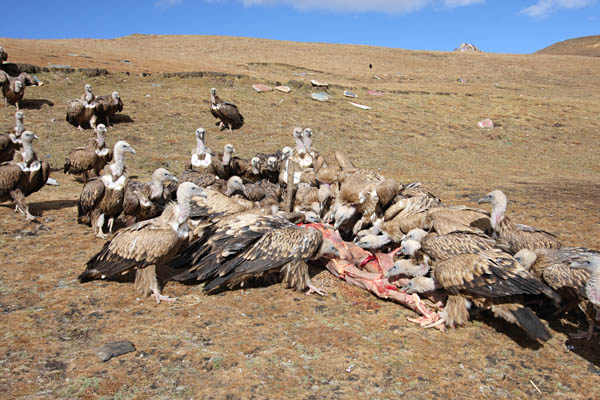

The Tibean practice of jhator, or sky burial, involves leaving bodies on high flat rocks so vultures can pick them apart.
Dorjee, an 18-year-old from the provincial town of Chara, set himself on fire yesterday then walked to a government office building and collapsed.
Rinchen, a 32-year-old mother of three, killed herself by self-immolation two days ago in front of a monastery in the Tibetan town of Ngaba. And the day before that, Tsering Kyi, a 20 year-old student from Gansu Province, set herself aflame in front of a vegetable market. These are the latest three cases of self-immolation to come out of Tibet, where more than two dozen people have set themselves on fire in the past year, protesting China’s repression of their homeland. “This third self-immolation in as many days underlines that Tibetans will not stop protesting until their calls for freedom are heeded,” the director of Free Tibet said in a recent New York Times article. The two female deaths represented the first time ever that Tibetan women who were not part of the clergy had killed themselves by self-immolation.
Self-immolation is not unique to Tibet. The revolutions that swept across the Middle East last spring began when a Tunisian street vendor named Mohamed Bouaziz set himself on fire after his wares were illegally confiscated. The practice dates back to first century China, when an official trying to induce rain during a drought set himself ablaze. Sati, a Hindu goddess of marital felicity and longevity sets herself on fire after her father refused to allow her to marry the man of her choice. And the Soshigateli, or self-burners, were devout Russian Christians who regarded death by fire as “the only means of purification from the sins and pollution of the world.”
Other Great Reads: “Fire baptism” and self-burning, from Saigon to Siberia
But in Tibet, destroying the body as a means of purification is a long-accepted method of disposal. A popular form of burial is an ancient gruesome practice known as jhator, or sky burial, in which bodies are left on high flat rocks for vultures. While the practice seems horrific to Westerners, it fits in fine with a Tibetan worldview. Most Tibetans are Buddhist and believe in rebirth, so the obsession with preserving the body that exists in America and Europe is absent. The body is an empty vessel, Buddhists believe, meant only to decompose. Plus, across much of Tibet, the ground is too hard and rocky to dig graves, and just below the surface begins a layer of impenetrable permafrost. The lack of timber and other fuel means cremation is costly.
Other Great Reads: More on Buddhist Burial Customs
The methods of jhator are recorded in the famous 12th century Buddhist treatise known as the Tibetan Book of the Dead. The procedure usually takes place at dawn, on a large flat rock higher than its surroundings. Relatives remain nearby, but in a spot where they cannot see the body directly. Before beginning, monks chant a mantra and burn juniper incense. In areas where so many burials take place that birds are often full and sluggish, a ritual dance occurs with the aim of coaxing birds to eat (the vulture that does the feasting is the Eurasian Griffon, or Old World Vulture; scientific name, Gyps fulvus). Special monks known as rogyapas, or body-breakers, begin disassembling the body. They talk and laugh while they work, as according to Buddhist teaching, this makes it easier for the soul of the deceased to move to the next life. First, the flesh is stripped from the body and set out for the vultures. Bones are broken up with mallets and ground, then mixed with a traditional dish called tsampa, consisting of barley flour mixed with tea and yak butter or milk. Many rogyapa will feed vultures all the bones and cartilage first, saving the best bits of flesh for last, such as the internal organs. Hair is usually thrown away but sometimes kept in a room in the monastery.
China considers the practice barbaric and had prohibited it during the 1960s but started to allow it again in the 1980s. Jhator is rarely ever observed by outsiders, but with the permission from the family a ceremony was filmed for a documentary called “Secret Towers of the Himalayas”, which aired on the Science Channel in the Fall of 2008. The camera crew was very careful as to never show the body itself, just the procedure, the birds, and the tools. Oddly enough, the gruesome practice does have a facebook page.
Have you been to Tibet? Or heard stories about sky burials? Share your experience in a comment below..
The most famous coroner on earth may well be Dr. Thomas Tsunetomi Noguchi, who was…
The day after Halloween, and the day after that, is Day of the Dead, and…
Following on his recent posts regarding deaths by extreme heat, Justin Nobel shares his thoughts…
Few parts of the country have been spared from July's soaring temperatures. In fact, July…
Deep inside a South African cave called Rising Star, scientists have made an incredible discovery—a…
Last week, in Nakano City, Japan, an evacuation center was opened in the gymnasium of…